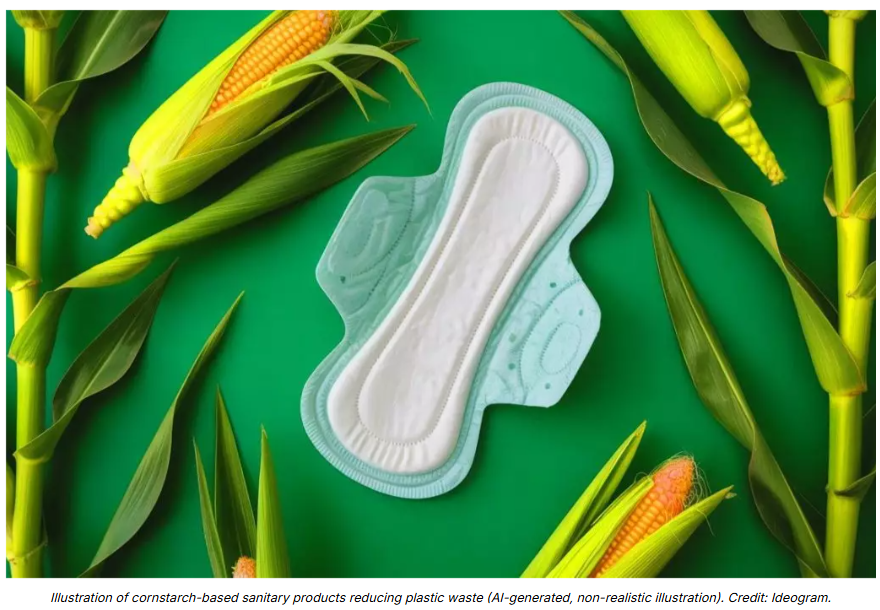In an unprecedented move toward sustainability, researchers have unveiled cornstarch-based sanitary products that promise to drastically reduce plastic waste, offering a scalable and cost-effective solution to a growing environmental crisis.

| IN A NUTSHELL |
| 🌽 Cornstarch-based sanitary products offer a sustainable alternative to traditional plastic pads, significantly reducing environmental impact. 🌍 These products, made from polylactic acid (PLA), are 17 times more environmentally friendly and help cut down on plastic waste in oceans. 💼 Despite the benefits, major manufacturers have yet to embrace these products fully, as large-scale production is needed for cost-effectiveness. 🔄 The adoption of cornstarch-based products could lead to economic and social benefits, driving innovation and creating new market opportunities. |
In the quest for environmental sustainability, researchers are uncovering innovative solutions to tackle plastic waste. One such breakthrough is the development of cornstarch-based sanitary products, which promise to significantly reduce the vast amounts of plastic waste generated by traditional sanitary pads. These new products, made from polylactic acid (PLA), offer a sustainable alternative that could revolutionize the industry. This article delves into the environmental benefits, challenges of adoption, and the potential for widespread implementation of these eco-friendly alternatives.
Huge Environmental Gains with Corn-Based Products
The shift to cornstarch-based sanitary products presents a promising opportunity to curb plastic pollution. Studies have shown that using PLA in sanitary products can result in 17 times less environmental damage compared to conventional plastic pads. This is significant given the staggering amount of plastic waste generated by traditional sanitary products, which equate to the plastic in four grocery bags per pad.
An estimated 264 pounds of menstrual products are used by an individual over their lifetime, with most containing a high percentage of plastic. This contributes to an alarming amount of plastic waste, especially in regions like North America, where around 55,000 tons of plastic sanitary waste are dumped annually into water bodies.
PLA-based pads not only reduce global warming potential but also minimize chemical toxicity during production. The use of plant-based PLA, as opposed to fossil-fuel-derived plastics, is key to this environmental benefit. Although the production of PLA requires more land, its renewable nature and lower emissions make it a viable long-term alternative.
Why Aren’t Big Companies Making the Switch?
Despite the clear benefits of cornstarch-based products, major manufacturers have yet to make a significant transition. One of the main hurdles is the need for commercial-scale production to ensure cost-effectiveness. However, the global prominence of corn as a crop offers an advantage. Corn is already massively cultivated for food, livestock feed, and biofuels, providing an established supply chain for PLA production.
Integrating cornstarch into existing supply systems could facilitate the adoption of PLA products without the need for new infrastructure. If major brands commit to manufacturing PLA-based sanitary products, the environmental impact could be transformative. This change could lead to less plastic waste, fewer toxins in water bodies, and a more sustainable future for menstrual health products.
While the potential for significant environmental benefits is evident, companies must be willing to invest in this change to realize these advantages fully. The research supporting these findings was published in the journal Sustainability Science and Technology.
The Economic and Social Implications of Cornstarch-Based Products
The adoption of cornstarch-based sanitary products carries not only environmental but also economic and social implications. As these products become more mainstream, they could stimulate new markets and create job opportunities in the agricultural and manufacturing sectors. The shift could also drive innovation, leading to further advancements in biodegradable materials.
Socially, the widespread use of eco-friendly sanitary products could enhance public health by reducing exposure to harmful chemicals found in traditional plastic-based products. Additionally, these products are poised to raise awareness about sustainable practices and influence consumer behavior toward more environmentally friendly choices.
The transition to sustainable sanitary products could also empower consumers by providing them with choices that align with their environmental values. This shift in consumer preference could pressure companies to prioritize sustainability in their product lines, leading to broader industry changes.
The Future of Sanitary Products: Challenges and Opportunities
The road to widespread adoption of cornstarch-based sanitary products is not without challenges. Scaling up production to meet global demand requires significant investment and innovation in manufacturing processes. Additionally, educating consumers about the benefits and availability of these products is crucial to driving demand.
However, the opportunities presented by this transition are immense. The potential environmental benefits, combined with economic and social gains, make cornstarch-based products a compelling alternative to traditional options. As awareness grows, the momentum for change could increase, prompting more companies to invest in sustainable solutions.
The ongoing research and development in this field highlight the importance of collaboration between scientists, manufacturers, and policymakers to overcome obstacles and pave the way for a more sustainable future. This collaborative effort is crucial for realizing the full potential of biodegradable sanitary products.
As the conversation around sustainability continues to evolve, the question remains: Will the industry seize the opportunity to make a lasting impact on the environment by transitioning to cornstarch-based sanitary products?
Article Credit: sustainability-times